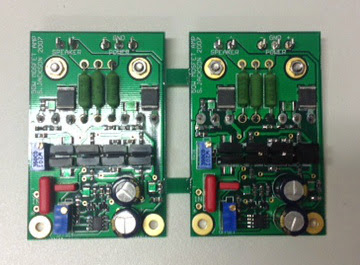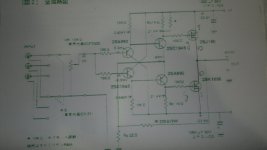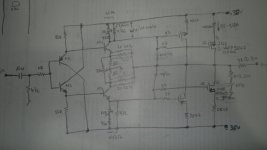What's so good about it?
It does have a large output blocking capacitor, which I don't think is too good for sound quality.
You may want to read the design notes, and check the specs.
I like the single-rail supply, as I will be re-using the transformer and case from a Dynaco SCA-80 to house it.
Hi,
Waybackmachine to the rescue:
A HiFi Power Amp
It should be noted that the design as such is not by Suzy, but adapted with minimal changes from David Tilbrook's AEM6000 design (something the original site clearly acknowledges BTW, in stark contrast to the habit of some here who routinely pass other people's designs off as their own, without attribution). So I kind of cannot see what Suzy is upset about.
As for the design itself, it is somewhat similar to the circuits by Lohstrom/Ottala/early Elektrocompaniet, but lacks the measures taken in the Lohstrom/Ottala to "broadband" the design. The output Fet's do not use any drivers with only around 10mA current available from the final VAS. Plus the selected semiconductors are mixture of poor linearity and poor availability.
So the open loop bandwidth and slew rate are compromised compared to what even much more pedestrian and simple designs can accomplish. So a lot of complexity without apparent performance improvements over more simple circuits, like the original Hitachi designs, due to a lack of optimising the topology for beast performance.
If we wanted something with Fet Input, there is an excellent design on page 150 of the Hitachi Application book, with more VAS current, simpler design and comparable or better THD Performance.
Ciao T
The 10mA VAS current is ample. Remember it's only a 100W amp with dual output transistors. Not a huge amount of capacitance to get over there. I tried sims with followers between the VAS and drivers and had no improvement in distortion, so didn't bother.
My approach to minimise distortion was by distributing gain across several stages with plenty of emitter degeneration, plus cascoding the JFETs and ensuring symmetry where possible. I's a straightforward approach that leads to an easily compensated, stable amplifier.
I don't really get your comment about broadbanding. The choice of topology in itself ensures adequate bandwidth.
I really don't get people claiming it's a complex design. It's really terribly simple. Input difamp, cascode, second stage differential complementary VAS and drivers. There are, what, 18 transistors discounting the output devices...
And there's nothing wrong with MJE340/350. They're reasonably fast, have appropriate Vce spec and are readily available. If you like faster VAS transistors slot them in, you'll get no great improvement in distortion. My only complaint these days is that the SST404s JFETs are a PITA to get (though Calogic still makes them).
I haven't asked anyone to remove schematics. I deleted the pages on my website years ago (though they're still on the wayback machine, obviously).
FWIW, here's my latest take on the basic AEM6000 topology. These little amps do 50W per channel with a single pair of Hitachi FETs on the output. Same JFET diffamp, same cascode, tweaked complementary differential VAS (with two fewer transistors, sacre bleau!). Still using MJE340 and MJE350 for the VAS. I took the main filter caps off the monoblock board and shrunk the whole thing to 75x50mm.
Better than 0.001% THD at 1KHz driving 50W into 8 Ohms, plus (thanks to the JFETs) 10nV/sqrtHz input noise. That gives me something like 110dB SNR. A huge bonus of the complementary differential design is excellent power supply rejection, of around 100dB.


The use for these amplifiers is to drive little speakers that I've mounted either side of the bed headboard in my accommodation at work (I have a room in work accommodation that I sleep in most weekday nights). The soundproofing is dreadful, so to ensure I don't annoy my neighbours I wanted something where I could listen at low volume without any annoying hum (good power supply rejection) or noise (the speakers are located around 30cm from my head), and still be able to crank up when my neighbours aren't around. I'm using a Per-Anders Sjöström QRV07 headphone amp (with TPA6120) as my preamp, and to drive some nice Sennheiser headphones (for when I want to crank it up with neighbours). These little amps perform admirably in this role.
Last edited:
The first amplifier that crosses my mind is MJ Amp, that also uses 2sk1058 and 2sj162 pair.
That amazing amp is very hard to construct because its Class A and needs very good care to tune , i did some prototypes by burning out many parts of output transistor It must be about 30w, but for sure no one would be regret to do that amazing amplifier , it has very warm and natural sound as a Class A.
It must be about 30w, but for sure no one would be regret to do that amazing amplifier , it has very warm and natural sound as a Class A.
Here is the real schema and i also attached the one that i tried to improve over 30w.
That amazing amp is very hard to construct because its Class A and needs very good care to tune , i did some prototypes by burning out many parts of output transistor
Here is the real schema and i also attached the one that i tried to improve over 30w.
Attachments
Last edited:
The 10mA VAS current is ample. Remember it's only a 100W amp with dual output transistors. Not a huge amount of capacitance to get over there. I tried sims with followers between the VAS and drivers and had no improvement in distortion, so didn't bother.
And there's nothing wrong with MJE340/350. They're reasonably fast, have appropriate Vce spec and are readily available. If you like faster VAS transistors slot them in, you'll get no great improvement in distortion. My only complaint these days is that the SST404s JFETs are a PITA to get (though Calogic still makes them).
If you drive mosfet directly from VAS, you need more than 10mA. The slew rate become low (but depend on the IPS topology, too).
MJE340/350 have high Cob, not good for VAS. The high frequency THD become higher if you use them. Please see Samuel Gorner note on Douglas Self book or read Douglas Self book lasted edition.
- Status
- This old topic is closed. If you want to reopen this topic, contact a moderator using the "Report Post" button.
- Home
- Amplifiers
- Solid State
- 2SK1058 and 2SJ162 amplifiers Collection

